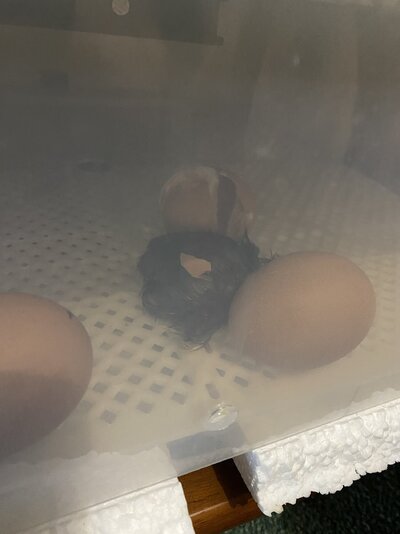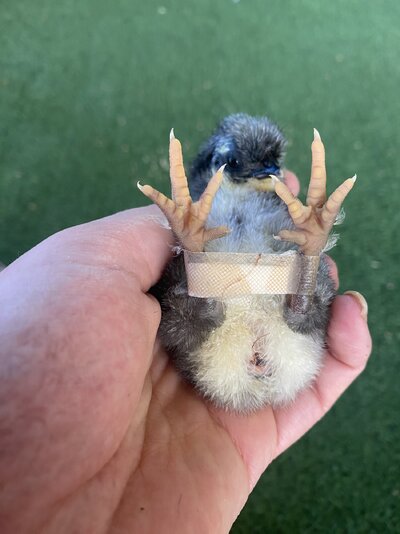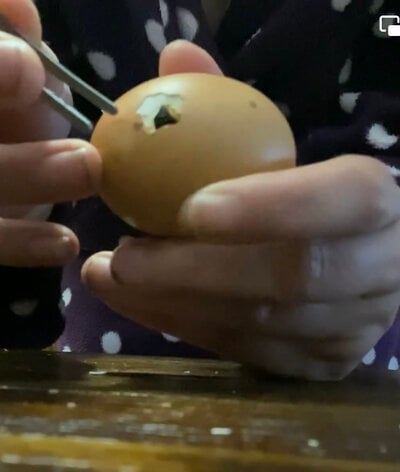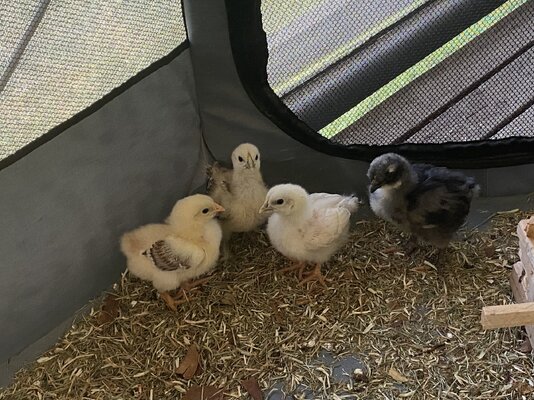Here at Cheeky Chicken Hobby Farm we like to share our experience for others as some things we have learnt as we go and others from professional insights and advice.
Video Link of the Hatch Assist
https://fb.watch/hdbGUutf5M/?mibextid=qC1gEa
Please be aware this is a controversial subject. Some people believe intervening is wrong and nature should take its course. Other will criticise and argue about the way you choose to intervene.
It can take up to 36 hours to go from pip until you chick hatches. After 48 hours I will also assist with this method even without signs of struggle or incorrect positioning.
Why I assisted this time.
At the end of day 22 this Australorp chick pipped at the wrong end. I straight away removed just the broken pieces of shell from the pip as sometimes their isn’t enough air for the chick when it pips at the wrong end. This is why it’s a large pip in the video.
I gave it 24 hours to make any progress, which it did not. Normally I wait 36 hours but the chick was cheeping a lot less then what I consider normal and when facing the wrong end of the egg it is a lot harder for the chick to turn and zip.
In my experience chicks that pip at the wrong end need help to some degree more than 75% of the time.
How I do it.
It is a humid 25 degree morning here so I was not concerned with taking the egg out for 4 minutes to do this. Any colder and I would of heated the room first. Sometimes I just go under my doona and do it as my body heat makes the area humid and warm as well.
I use tweezers as you can see. Other people like to use coconut oil to keep the membrane moist and to avoid shrink wrapping. I do not do this only because nothing negative has ever happened with an assist. Maybe because I’m quick, have warm hands and a warm humid house or I’m just lucky. However, I do recommend you moisten the membrane with some oil.
Grab a que tip and just slightly moisten the tip. Then gently rub the membrane. You want to use as little as possible to avoid drowning the chick and causing further issues. Coconut oil is thicker and does not run, this is why I recommend it.
First I check which way the chick is turning to zip. You can tell as the beak generally has moved from the spot it has pipped and therefore, whichever way it has turned is the way it will zip.
I take a small amount of shell in the direction the chick is going to zip and then turn the egg and go the other way. You’ll see I did it both ways this time, this was because while I was holding the egg, the chick turned further. This can happen when your assisting because as you remove shell, it makes that little bit more room for the chick to turn.
Also you’ll see that I stopped going one way because the shell was still stuck to the membrane and I did not want to risk ripping the membrane.
I do my best to mimic how a chick zips.
I remove very small pieces of shell at a time, SHELL ONLY, if you rip the membrane your chick could bleed to death.
I go about 40% of the way and then put the chick back in the incubator to try it’s own luck for another 12 hours. If there is no progress and/or reduced cheeping I will then go 95% of the way around and then put the egg back.
I wait another 3-5 hours (depending on what I’m doing that day or if it’s late and I want to go to bed). If the chick has not broken out, I then do it for it.
Warnings and Cautions
If you nick any of the two membranes and there is only enough blood to just moisten the edge of the rip, don’t stress. If there is enough blood that it drips, freak out a bit. Stop everything, put the chick back and go to the next step of waiting 12 hours and looking for signs of struggle.
If blood loss occurs in any amount, the chick will take 12-24 hours longer to get its strength. A significant amount of blood loss (drip) will result in needing extra fluid and vitamin water for the first 48 hours. I once had a chick bleed a significant amount while hatching because chicks where walking all over it’s egg and caused issues. I do not like to isolate if a chicken is not contagious, so I put it with one other chick and encouraged extra fluid intake and provided vitamin water for the first 48 hours. Chicks do not need food or water for the first 48 hours after hatch, I am referring to after this period. The chick that had blood loss is now 4 weeks, well feathered, active, just a bit smaller then the others.
I checked the chick every hour (because I have an unhealthy obsession with my chickens ) and 12 hours on the dot, the chick was out.
) and 12 hours on the dot, the chick was out.
It has now been a few weeks, the chick did have splay leg which we treated and it is now off with the other hatchlings running around. We have a seperate post on our Facebook page detailing our treatment.
His name is penguin.
I generally end up assisting 2-3 eggs per hatch and there can be 50-200 eggs per hatch. So far only one has been euthanised at day 4, it had neurological issues that resulted in it being unable to properly walk and move the right side of its body. All other assists have ended in no long term issues and a happy life.
Video Link of the Hatch Assist
https://fb.watch/hdbGUutf5M/?mibextid=qC1gEa
Please be aware this is a controversial subject. Some people believe intervening is wrong and nature should take its course. Other will criticise and argue about the way you choose to intervene.
It can take up to 36 hours to go from pip until you chick hatches. After 48 hours I will also assist with this method even without signs of struggle or incorrect positioning.
Why I assisted this time.
At the end of day 22 this Australorp chick pipped at the wrong end. I straight away removed just the broken pieces of shell from the pip as sometimes their isn’t enough air for the chick when it pips at the wrong end. This is why it’s a large pip in the video.
I gave it 24 hours to make any progress, which it did not. Normally I wait 36 hours but the chick was cheeping a lot less then what I consider normal and when facing the wrong end of the egg it is a lot harder for the chick to turn and zip.
In my experience chicks that pip at the wrong end need help to some degree more than 75% of the time.
How I do it.
It is a humid 25 degree morning here so I was not concerned with taking the egg out for 4 minutes to do this. Any colder and I would of heated the room first. Sometimes I just go under my doona and do it as my body heat makes the area humid and warm as well.
I use tweezers as you can see. Other people like to use coconut oil to keep the membrane moist and to avoid shrink wrapping. I do not do this only because nothing negative has ever happened with an assist. Maybe because I’m quick, have warm hands and a warm humid house or I’m just lucky. However, I do recommend you moisten the membrane with some oil.
Grab a que tip and just slightly moisten the tip. Then gently rub the membrane. You want to use as little as possible to avoid drowning the chick and causing further issues. Coconut oil is thicker and does not run, this is why I recommend it.
First I check which way the chick is turning to zip. You can tell as the beak generally has moved from the spot it has pipped and therefore, whichever way it has turned is the way it will zip.
I take a small amount of shell in the direction the chick is going to zip and then turn the egg and go the other way. You’ll see I did it both ways this time, this was because while I was holding the egg, the chick turned further. This can happen when your assisting because as you remove shell, it makes that little bit more room for the chick to turn.
Also you’ll see that I stopped going one way because the shell was still stuck to the membrane and I did not want to risk ripping the membrane.
I do my best to mimic how a chick zips.
I remove very small pieces of shell at a time, SHELL ONLY, if you rip the membrane your chick could bleed to death.
I go about 40% of the way and then put the chick back in the incubator to try it’s own luck for another 12 hours. If there is no progress and/or reduced cheeping I will then go 95% of the way around and then put the egg back.
I wait another 3-5 hours (depending on what I’m doing that day or if it’s late and I want to go to bed). If the chick has not broken out, I then do it for it.
Warnings and Cautions
If you nick any of the two membranes and there is only enough blood to just moisten the edge of the rip, don’t stress. If there is enough blood that it drips, freak out a bit. Stop everything, put the chick back and go to the next step of waiting 12 hours and looking for signs of struggle.
If blood loss occurs in any amount, the chick will take 12-24 hours longer to get its strength. A significant amount of blood loss (drip) will result in needing extra fluid and vitamin water for the first 48 hours. I once had a chick bleed a significant amount while hatching because chicks where walking all over it’s egg and caused issues. I do not like to isolate if a chicken is not contagious, so I put it with one other chick and encouraged extra fluid intake and provided vitamin water for the first 48 hours. Chicks do not need food or water for the first 48 hours after hatch, I am referring to after this period. The chick that had blood loss is now 4 weeks, well feathered, active, just a bit smaller then the others.
I checked the chick every hour (because I have an unhealthy obsession with my chickens
It has now been a few weeks, the chick did have splay leg which we treated and it is now off with the other hatchlings running around. We have a seperate post on our Facebook page detailing our treatment.
His name is penguin.
I generally end up assisting 2-3 eggs per hatch and there can be 50-200 eggs per hatch. So far only one has been euthanised at day 4, it had neurological issues that resulted in it being unable to properly walk and move the right side of its body. All other assists have ended in no long term issues and a happy life.





